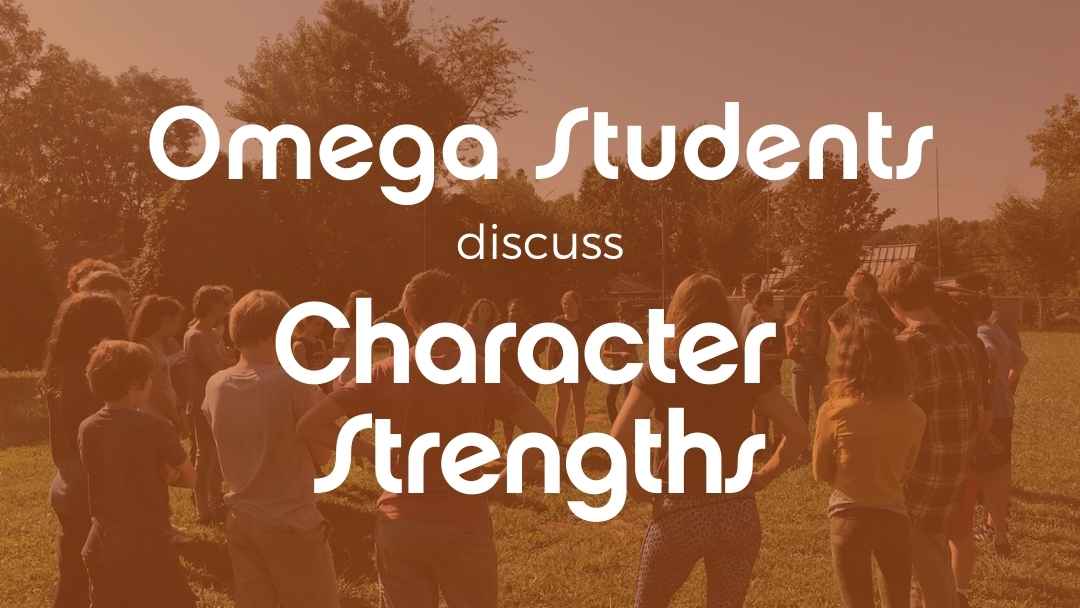
by Cynthia Calhoun | Oct 17, 2019 | News
Character Strengths & Being a Changemaker
Recently, Omega 7/8 students gathered in a circle in the Social Studies room to talk about their character strengths, how all that ties in with learning, and being a changemaker. In a previous class, they watched a short video about the Science of Character. In this class, they looked at their own character strengths as a way to look at themselves as they are now, and who they want to become. They completed a “periodic table of character strengths.”
As students gathered in circle, their teacher, Jason, asked them for a willingness to be a little vulnerable as they embarked upon a conversation that would certainly involve sharing personal information about one’s character – not a task that’s so easy to do. Our Omega 7/8 students, however, were up for the challenge.

Omega 7/8 students ponder questions about character strengths and about being changemakers.
Jason posed quite a few questions that made students really look at how or why they do the things they do. “Why explore character strengths?” was one question he asked, to which students answered, “Many current changemakers have these strengths and that can help others become changemakers themselves and live out their truth.”
Character Strengths at School and in US Culture
Another question: What character strengths do you think are valued at our school? They answered with a number of terms:
- creativity
- teamwork
- kindness (especially in wanting everyone to feel welcome)
- leadership
- spirituality (through centering and other activities)
- perseverance
- honesty
- love of learning
Jason followed up with, Are these the same character strengths that are valued in our culture? For a few quiet moments, students pondered their responses. Several offered their insights: “these are supposed to be values in our culture, but it doesn’t always happen that way. We’re supposed to be kind but you don’t always see that, and through some of the language and actions were seeing, kindness is not always there.”

A few student examples of the “Periodic Table of Character Strengths”
J: Does that make it hard to value certain character strengths?
S: If you believe in these values, sometimes it’s not always easy to stand by them.
J: Which strengths are important to have or develop in a digital world?
S: Creativity, social responsibility, and gratitude. With social responsibility comes the idea that one must think critically in response to what’s online. It’s also important not to take for granted everything that comes to us as “easy.”
Fixed vs. Growth Mindset
Jason invited the Omegans to reflect on the idea of a fixed mindset versus a growth mindset the video covered as a topic. A fixed mindset is the belief that you cannot change who you are. A growth mindset is the belief that you can. This was a segue into the next probing question:
J: Is there an area where you have a fixed mindset about something?
S: Yes. When you don’t feel like you’re good at math or reading, that you can’t draw, or that you always procrastinate to get things done.
J: Is there any character strength that might help you shift out of a fixed mindset?
S: Yes: perseverance in which you keep trying to do something. There’s acceptance, where you accept that perhaps a subject isn’t your favorite but you can keep working at it. It’s an opportunity to be gentle with yourself and accept that this is where you are. Still, there’s curiosity. If you have a certain belief about something, such as “I’m not good at math,” you can adopt an attitude of curiosity.
J: When you’ve failed at something, how did you feel?
S: Anger, directed at the self, or it’s possible to even feel like a failure. Feelings of discouragement, being scared, or being fearful can happen, too. Being mad at yourself, however, won’t get you anywhere.
Learning from Failure
At this, everyone paused. Jason offered words of wisdom, as well as encouragement: These emotions can and do arise. It’s even possible to let fear get in the way of you trying again. This can be a great opportunity for self-reflection in which you ask, “what could I have done differently? What can I learn from this?”
J: Is it okay to fail?
S: Yes. We can learn from it. But it can also be hard.
J: What is it that you want to achieve?
S: That is a hard question: it makes you think about the future. Perhaps write a book. Be the smartest person that ever lived. Maybe doing a job that you “like to do” instead of something that is forced. You can make goals for yourself.

A small poster hangs in the Social Studies room – a relevant question when determining character strengths.
Again, Jason offered his wisdom as their teacher. It’s up to you to find your truth. You also need to determine what lights you up. The way to grow your strengths is to be around others who have strengths that you would like to develop.
As students concluded this portion of their lesson, they pensively began other projects. They demonstrated such wisdom and a complex understanding of life and its lessons. This is something we’ve come to expect of our Omegans: they embrace the journey and take charge of their learning in all Seven Domains. It is in that spirit they use their internal wisdom to guide their decisions as they navigate academics, the adolescent years, friendships, and so much more.
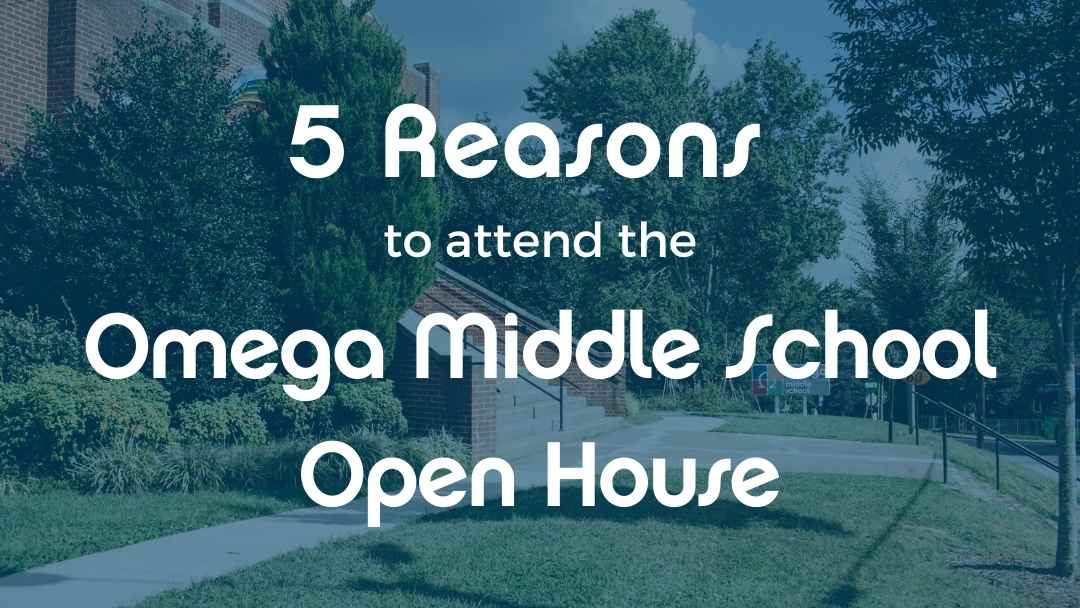
by Cynthia Calhoun | Oct 10, 2019 | Events, News
You can learn so much at the Omega Middle School Open House
Our Omega Middle School Open House is right around the corner. We hope you will take some time to be part of this event, no matter your child’s grade in elementary school or middle school. It gives you an opportunity to see a Rainbow / Omega education across the grades, culminating with the 7th and 8th grade years in which students engage in larger projects, presentations, and leadership opportunities.
What made me a supporter of Rainbow, was the kids’ strong sense of self. They knew who they were and were not. They knew their strengths and weaknesses. And even though high school and college brings its own set of social and educational challenges, the students I met were at peace with themselves, ready to take on the challenges of young adulthood with confidence and determination. —Bill Drew, parent of a current 5th grader
Here is this year’s schedule:
Morning Session
8:30 – 10 am
- 8:30 – 8:45 coffee/tea/chocolate in the auditorium foyer
- 8:45 – 9:00 short presentation about Omega Middle School
- 9:00 – 9:30 tour classes in progress
- 9:30 – 10 Q & A with current teachers & students back in the auditorium
Evening Session
6:30 – 8:00 pm
- 6:30 – 6:45 – pizza and salad in the auditorium foyer
- 6:45 – 7:00 – short presentation about Omega Middle School
- 7:00 – 7:15 – tour classrooms
- 7:15 – 8:00 – meet recent graduates and ask questions with our alumni panel
The five big reasons you should come to the Omega Open House:
1. Meet teachers
During the school year, it’s not always so easy to speak with a teacher who is not attending to other tasks – students, planning, teaching, training, in a meeting, etc. Having their undivided attention to answer all your questions about what they teach and how becomes such a gift! The open house provides you this opportunity. Meet all the teachers in our Omega Middle School: Susie (division head), Susan, Jason, Niki, Justin, Lisa, Jenny, and some of our specialists.

2. Meet students
We love opening up our campus so that you can meet students and see how incredible they all are. The programs and curriculum in the Omega program allows them to explore their interests more in-depth through our regular academic program and through our electives classes. We have extensive electives courses and our students can tell you about them.

3. Meet recent graduates
You also have an opportunity to hear from recent graduates who can give you candid answers about how prepared they felt for high school. They can share about their Rainbow experiences, the transition to high school, and tell you much more about their academic and extracurricular careers as a result of their Rainbow / Omega experience.
You can get a great feel for how this works with our past alumni panels who have spoken at other Open Houses:
4. Visit classes
On the morning of the Open House, you can see classes in progress. On any given day, students engage in different experiential activities involving collaboration, problem solving, math, language arts and social studies.

5. Get all your questions answered
We cannot stress enough the value in being part of an event like this. You get to see the “whole Rainbow story” and how proud we are of our young students and who they grow to be.
Last year, one parent attended and felt so moved by the event, he wrote a long letter of how this event alone helped him decide on a middle school for his child. Take a look! at Bill Drew’s Testimonial Letter.
We hope you will join us for an evening of connection, information, and fun! We’ll have door prizes and other giveaways, too!
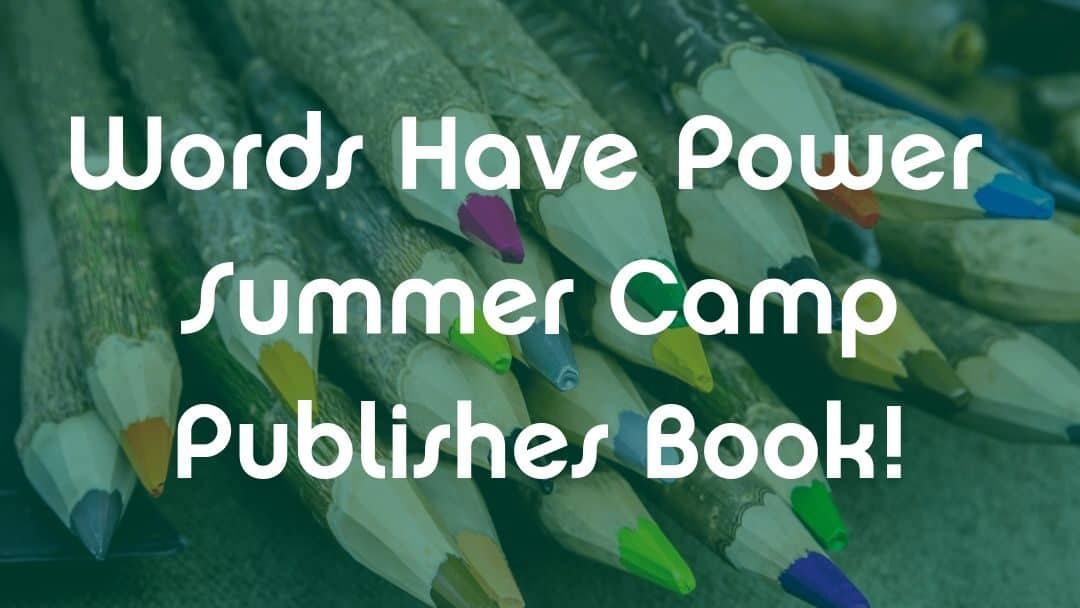
by Cynthia Calhoun | Sep 25, 2019 | Blogs, Home Page News, Student News & Accolades
Words Have Power Summer Camp
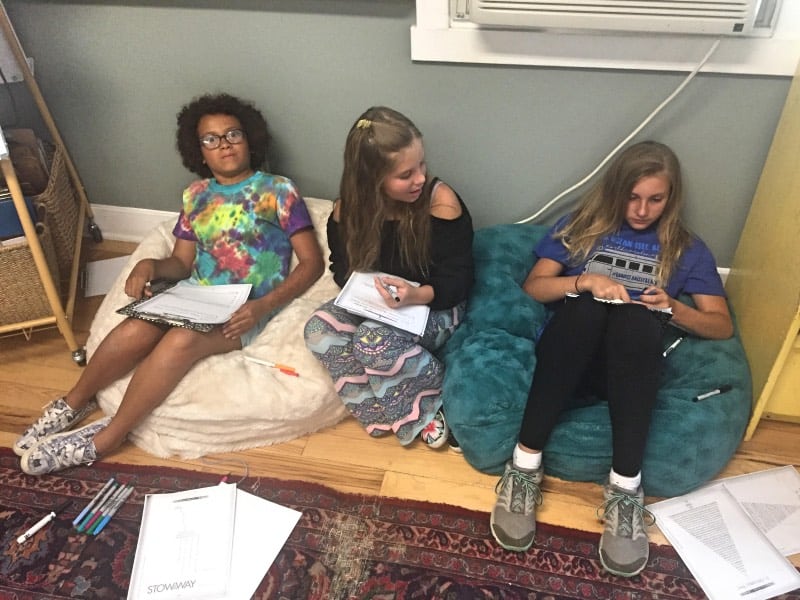
In summer 2019, Rainbow Community School had the Words Have Power summer camp. April Fox taught this camp with such incredible results! This camp was for ages 10-13, with a total of 10 students attending for the week. The students who participated published an anthology of their work. April, their teacher, compiled all their writings and it’s now available on Amazon.
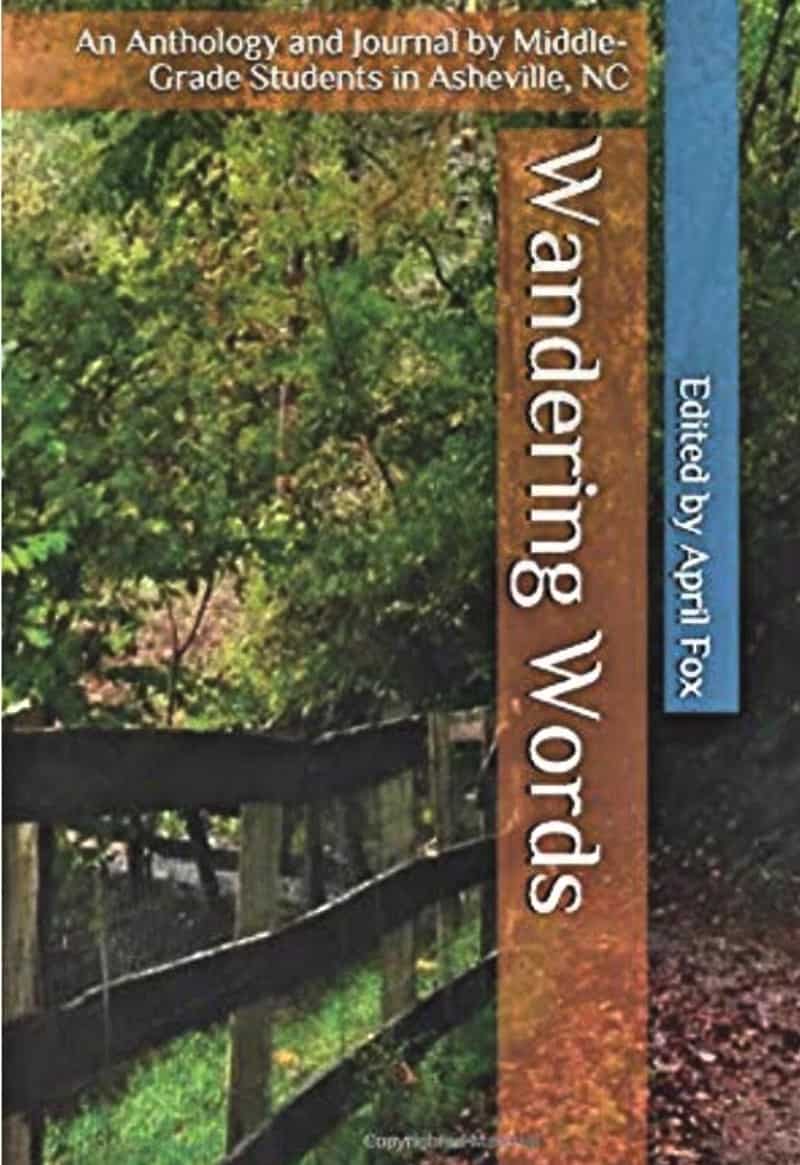
Anthology cover. We have a copy in the Main Office!
We interviewed April who told us the whole idea of the camp was to allow kids to explore writing “without all the rules.” She showed her students that there’s “school writing” and there’s also “fun writing.” April wanted her students to know that there is a world of writing outside of grammar, spelling and following conventional rules.
This was a camp that gave students a chance to explore writing in a creative way – possibly in ways they had never done before. They used words for nothing but the “pure expression of what was in their heads,” which allowed them to truly connect with the idea of writing on a different level.
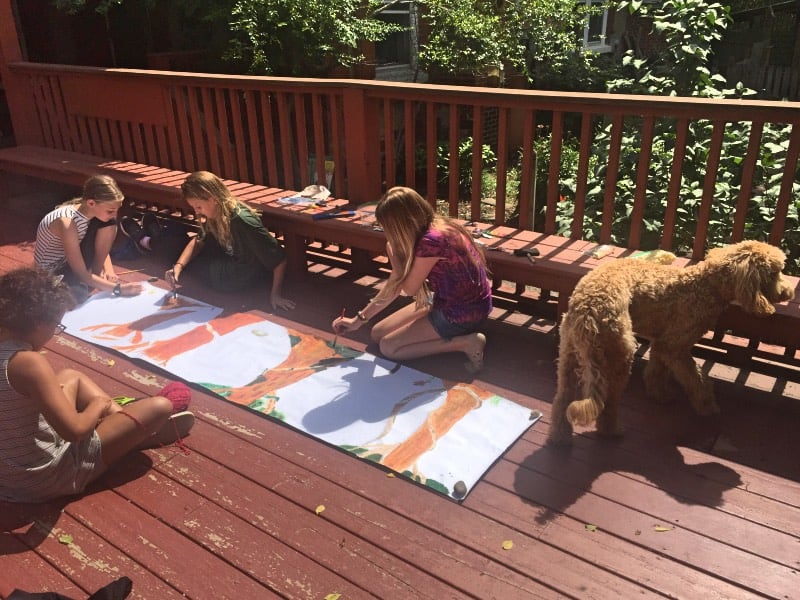
Each morning, April would put up quotes from different writers or inspirational figures that had something to do with writing or succeeding. Students would pick their favorite quote and write in their journals, reflecting about how they felt, or scribbled other musings related to the quote they chose. These quotes came from different artists and writers, such as Maya Angelou, Tupac, Elvis Costello and many others.
How the anthology came about
Students studied different types of writing throughout the week. One activity they did was to use pictures to inspire their writing. If they saw a photo of a butterfly that inspired them, for example, they could write a poem in response, and perhaps “shape it” in the form of butterfly wings.
They did a lot of free writing, haikus and had the freedom to explore whatever type of writing style that interested them, from short stories to graphic novel layouts. They even explored writing a screenplay and all that went with it: writing, directing, rehearsing and performing their written words. Students were allowed to edit their work or not, depending on how they felt about it.
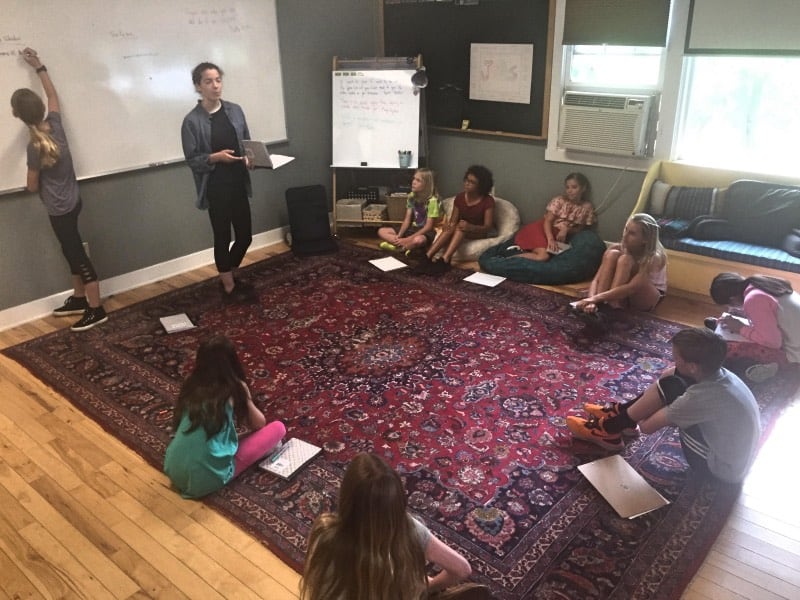
At the end of each day students could elect to turn their work in to be part of an anthology that April would put together later in the summer. After the camp ended, she spent time compiling and typing out each of the writings her students submitted. She remarked that some poems were funny, some were more serious, some explored serious issues and other poems touched on lighter subjects, such as smelly socks. In effect, these poems were a snapshot of this particular age group, and allowed their individual selves to come out. They had no filters. Their work reflects what was in their heads at that moment.
Student success
April considers the most successful part of the week to be when she witnessed an increase in student confidence with regard to their writing. They produced some insightful, heartfelt, and well-written work. They learned that even though they might struggle with specific aspects of writing academically, they can still be incredible storytellers, and write pretty remarkable content.
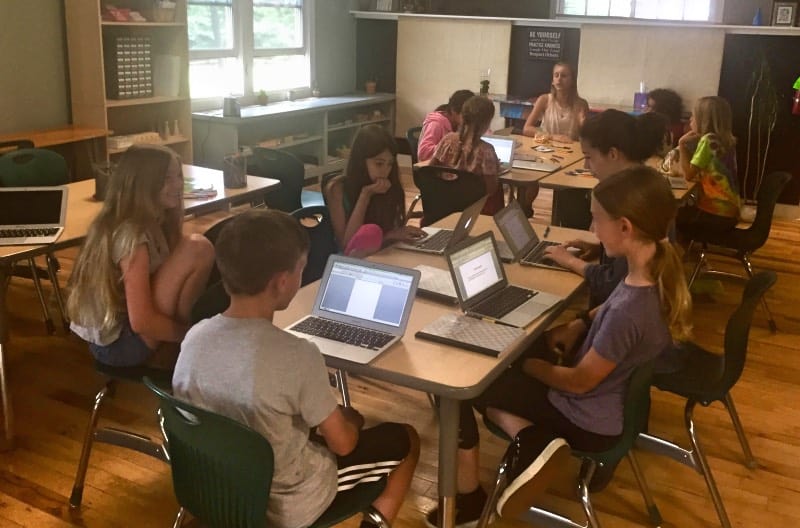
All photos courtesy of April Fox. We have a copy of the anthology in the Main Office!
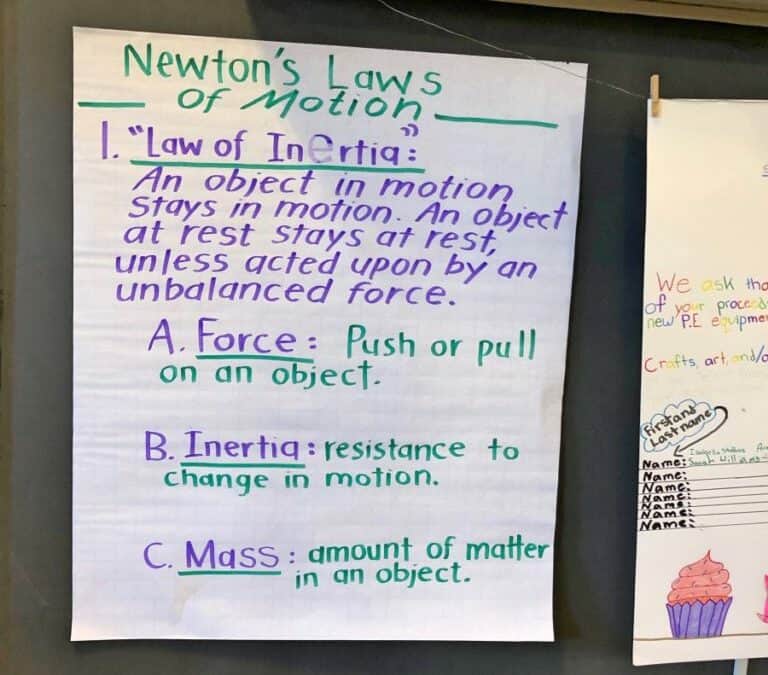
by Cynthia Calhoun | Feb 7, 2019 | News
Newton’s Laws of Motion
We stepped into sixth grade recently to find them learning about Newton’s Laws of Motion.
But it wasn’t just any science class. The Kitsune created flipbooks to illustrate their understanding of these universal laws.
The first law of motion is that an object in motion stays in motion. An object at rest stays at rest, unless acted upon by an unbalanced force.
Kitsune teacher, Jenny, created these incredible posters that illustrated Newton’s laws.
Newton’s Second Law of Motion
The second law of motion is that Force (f) = mass (m) x acceleration (a).
Newton’s 3rd Law of Motion
The third law of motion is that for every action, there is an equal and opposite reaction.
Science and Rollercoasters
A day earlier, students created a marble roller coaster. They were applying the principles of what they had learned about energy and the laws of motion, specifically, Newton’s 2nd law. Their challenge was to build a roller coaster that would allow the speed of a marble to speed up or slow down using inclines, different materials or textures, and the like.
Persistence of Vision
Before diving into flipbooks, the Kitsune recently spent part of their morning talking about the “persistence of vision” in which students brainstormed some concepts about what this was. Persistence of vision, as it relates to animation and film, includes three main ideas:
- optical illusion
- the human eye can process 10-12 images per second
- the faster the images go, the more they seem to be in motion
That is, the human eye effectively “retains” an image up to a fifteenth of a second. If you “speed up” looking at different images, they will appear to move due to this phenomenon.
To illustrate this, Jenny, had students create and imagine a few drawings of what “running” would look like.
They had a chance to see different examples of flipbooks.
After they got all inspired, Jenny showed them what a story board looked like.
Their objective: create a 30-page flip book that illustrates the principles of Newton’s Laws of Motion.
Students would also need to write a paragraph explaining the action that happens their flip book, as well as how the action illustrated Newton’s laws of motion.
We’ll update here when we see the final flipbook creations students have created.
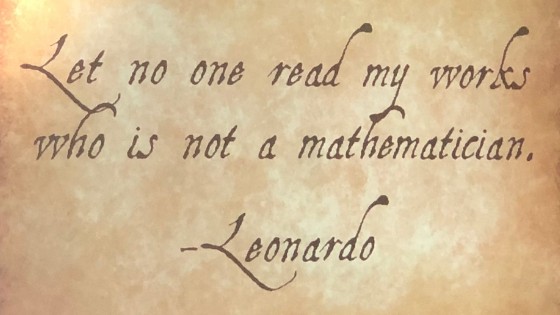
by Cynthia Calhoun | Oct 25, 2018 | News
So many things…all in a day’s work
Sacred geometry, science experiments, and literacy – all in a day’s work. Maybe not even a day’s work, but in the span of an hour and a half, students experienced some incredible learning.
Language Arts
It was mid-morning, and students were well-immersed in their classes.
Teachers create units that complement each other. Today’s activity included vocabulary words that would come up in science class later in the morning. Students were likely not familiar with them.

Susan, their teacher, had them study the list of words for two minutes. We love that some kiddos wanted to know why they needed to study and memorize them. Susan had them “sit tight” because they would find out in a few minutes.
At the end of the two minutes, students turned their papers over and had one minute to write down the words they remembered. Afterward, some folks remembered 2, 3, or 5 words, and one student had 15!
Learning strategies
Some students had words from an “A” list, or from a “B” list. The words on each list had different characteristics. Some words were bold, some were in alphabetical order, and more.
Students discussed their strategies for memorization. One student said he memorized words in groups. Another said she put a description with each word. Others mentioned eliminating words that were too long, repeating different words over and over, and some tried writing them down.

Learning objective
The idea here was that It’s important to try different learning strategies. By doing so, students can figure out what works best for them, and what doesn’t. By sharing ideas, everyone could learn a strategy that maybe they hadn’t tried previously.
Learning games
Next came cutouts of the vocabulary words. Students split into groups of 3 (with 8 vocabulary words each) or 4 (with 6 vocabulary words each) to collaborate and separate their vocabulary into categories. They were allowed to discuss and work together to do so. Susan instructed them not to worry about words they didn’t know, but to work together to see if someone else knew the meaning. If not, they could use deductive reasoning to separate them out.
What a way to learn vocabulary. Students had some fun and challenging approaches to learning new words. They will then relate them back to their science learning, as well as tie their different classes together to touch on the different domains. The lessons on this day emphasized the mental and creative domains.
Art History
Across the hall, another Omega class studied art history and math. It wasn’t just another garden-variety middle school class, however. Their teacher, Mark, was incorporating elements of sacred geometry.
Sacred geometry is an area of intense interest for Mark. In fact, he’s publishing a book on the subject soon.
While in his class, students studied Renaissance paintings and works by Da Vinci, Michelangelo, Verocchio, and others.

Da Vinci and math
While listening to Mark’s lecture, students were quite riveted with the presentation. Mark mentioned how Da Vinci was a great artist, AND used mathematics heavily in his work.
Incredibly, perspective and sacred geometry came into play. The proportions of the human body, for example, represent universal sacred geometry parameters. Da Vinci’s paintings include so much symbolism as well as “hidden” geometry, especially in his human subjects.
For example, one might be able to find evidence of the sacred spiral or even phi ratios in different Da Vinci paintings.

Students had a chance to try their hand at creating their own works of sacred geometry. They used a compass and ruler and made their own golden rectangles, along with sacred spirals.
They also saw examples of how those patterns show in up nature on the most minute scale (such as with tiny seashells) all the way up to a universal scale, such as with spiral galaxies.

The “Eggs-periment”
Back in the science classroom, the Omega group that had become vocabulary masters began delving into their new science unit.
They began an investigation involving the standard egg. They chose to either do an “egg-speriment” or “what about other eggs” for their research.
The eggs-periment involved observing changes in an egg and recording those observations. The latter assignment gave students the opportunity to study an egg-laying creature to investigate.
Both projects required entries into student science journals, presentations, making models, and writing effective science reports.

Omegans have a rich curriculum
All these interesting subjects, all by the noontime hour! We can only imagine what happened after lunch. All in a day’s work.

by Cynthia Calhoun | Sep 25, 2018 | News
Opening the Heart – Reflection and Centering
At a recent admin meeting, Cynthia shared a centering designed to bring awareness to, and open the heart. Renee asked her to share it on the Director’s Blog for others to enjoy, as well.
Point to yourself
Take a moment to close your eyes and relax into the rhythm of your breath. When you feel more relaxed, go ahead and point to yourself.
Notice where you are pointing. Chances are, you’re pointing toward your heart, or somewhere near your heart chakra.
This is on purpose. We humans point to the heart because we intuitively know our truest selves are not the brain, but the heart. The heart serves as a secondary brain and even has its own magnetic field.
What we do with the heart
We do a lot with the heart. We have heart-to-heart conversations. When we’re happy, our heart swells. When we’re sad, we’re heartbroken.
In the presence of beauty, we say we’re heartened. When we like someone, we say that they have a kind heart. A trustworthy, well-meaning person has a heart of gold. Conversely, a cold, unforgiving person has a heart of stone. When we feel bad for someone, we say, “bless their heart.” When we experience surprise, our heart skips a beat.
When we see someone’s heartfelt actions, we know it’s them expressing their truth. Furthermore, we send heart emojis when we mean to send loving thoughts.
Some of us wear our hearts on our sleeve.
Caring for our “heart self”
Our culture values the relentless pursuit of knowledge. We feed the mind. We feed the brain. We spend decades educating ourselves. But how often do we remember to feed the heart? How often do we remember to care for our heart self?
When we focus on the heart, our communications improve. Our relationships flourish. Still, our hope for the world turns rosier, as if we put on rose-colored glasses.
Pink and green
The color pink is the representation of the heart and a symbol of romantic love. On the other hand, the heart chakra is green. It’s the opposite of rose. Green is a color of expansion, growth, openness and unconditional love – love for self and love for others. The heart chakra sits in the center of the chest, not at the heart as many believe.
As a centering, we can do a little care for the heart – the heart itself, and the heart chakra.

A heart-centered breath
This is a practice that you can do at any time: while going about your day, while meditating, while exercising, or wherever.
Sit with your feet flat on the floor, or in a comfortable position. Hands can rest on your lap.
Relax your body. You can keep your eyes open, capped (open half-way) or closed.
Bring your attention to the breath as you breathe through the nose. Feel the cooler air as you inhale, and warmer air as you exhale. Don’t control or regulate your breath. Just observe.
Focus your attention…
Now bring your gentle attention to the rise and fall of the chest. Gently move your attention to the heart. Visualize your breath moving in and out of your heart space, filling it with soft green light and exhaling that same green light into the air around you.
Move into silence for three or four breaths, with each inhale and exhale taking in the easy green light and filling your heart space. Your exhale fills the air with this same light.
If you notice your thoughts wandering, just bring them back to the heart, and the light. Be kind to yourself.
After a few moments, bring your attention back to the breath. When you’re ready, open your eyes if you had them closed or capped.







































